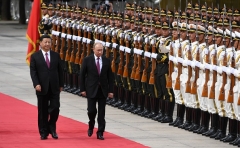
Russian President Vladimir Putin and Chinese President Xi Jinping review an honor guard in Beijing in 2018. Military cooperation between the two nations has stepped up since 2012. (Photo by Greg Baker/AFP via Getty Images)
Moscow (CNSNews.com) – Russia and China this week kicked off a large-scale military exercise in southern Russia along with troops from several other countries – including Iran – at a time when all three countries’ relations with the United States are chilly.
The Kavkaz 2020 drills are running from September 21 to September 26 in Russia’s Southern Military District, near the Black and Caspian Seas. The exercise will involve 80,000 military personnel, 450 mechanized infantry fighting vehicles, 250 tanks, 200 artillery and multiple-launch rocket systems, and an undisclosed number of warships.
“The Kavkaz-2020 drills will particularly focus on combating cruise missiles and unmanned aerial vehicles, as well as on fire and electronic warfare activities against entire enemy formations, on training airborne troops’ vertical envelopment capability and ways to rapidly shift between military activities,” the Russian Defense Ministry stated on Monday.
The ministry reported that up to 1,000 troops from China, Pakistan, Belarus, Burma, and Armenia are participating in the exercise. Additionally, Iranian warships will join the participants for naval drills in the Black and Caspian Seas.
In a statement earlier this month, the Chinese Defense Ministry said China’s participation “aims to further develop the China-Russia comprehensive strategic partnership of cooperation in a new era, deepen the pragmatic cooperation in military training between the two sides, and boost the capacities of military forces from different countries to jointly deal with security threats and safeguard regional peace and stability.”
Over the past decade, Russia and China have expanded military cooperation as both governments’ relations with the United States soured.
The developments have sparked growing unease in the West. In June, NATO Secretary General Jens Stoltenberg warned that China’s rise along with its increasing cooperation with Russia posed a new challenge for the alliance.
“We see [Chinese forces] in the Arctic, in Africa. We see them investing in our critical infrastructure,” he said. “And they are working more and more together with Russia. All of this has a security consequence for NATO allies.”
Commenting on the Kavkaz 2020 exercises Alexander Mikhalkov, director of the Moscow-based think tank Bureau of Military-Political Analysis, told the pro-Kremlin RT network that while the drills were mostly for planning purposes, they “have assumed a special geopolitical significance in light of the growing NATO military activity on the southern borders of our country.”
“Of particular concern are the flights of U.S. strategic bombers near the Russian border,” he said. “I think the current strategic exercise by Moscow allows the alliance to understand that any provocations in the area of the Crimea, the Azov River and the Black Sea coast will end badly for any potential aggressor.”
Russia and China have held annual joint naval exercises regularly since 2012, in flashpoint regions such as the South China and Baltic seas.
In the fall of 2018, China sent 3,200 troops and 900 tanks to eastern Siberia for Vostok-2018, Russia’s biggest military exercise since 1981, featuring over 300,000 troops and 36,000 tanks. Beijing again dispatched troops the following year for Russia’s Tsentr 2019 exercise, which involved 128,000 soldiers, 20,000 units of military equipment, and 600 aircraft.
In July 2019, the two countries conducted their first ever joint bomber patrol over the Sea of Japan. South Korea and Japan both protested the drill as a violation of their airspace.
Beyond joint military exercises, Russia has also begun supplying China with some of its most advanced weaponry. In 2014, Russia agreed to sell six battalions of its S-400 air defense system to China for $3 billion. The following year, China purchased 24 Su-35 fighter jets from Russia for $2 billion.
In October 2019, President Vladimir Putin announced that Russia was helping China develop its own missile warning system, a closely-guarded technology that currently only the U.S. and Russia possess.
Last month, Russia’s Federal Service for Military-Technical Cooperation announced that the two countries had begun working together to develop a new generation non-nuclear submarine.




